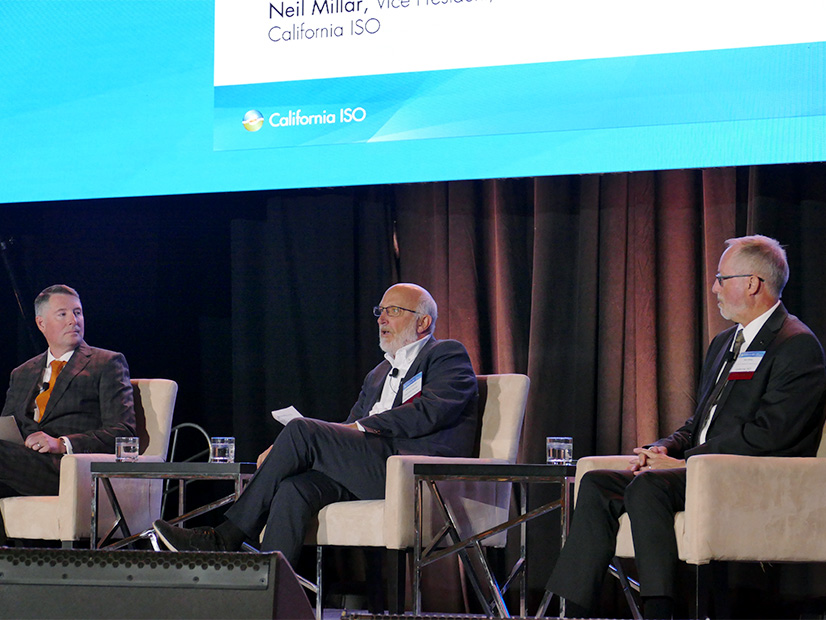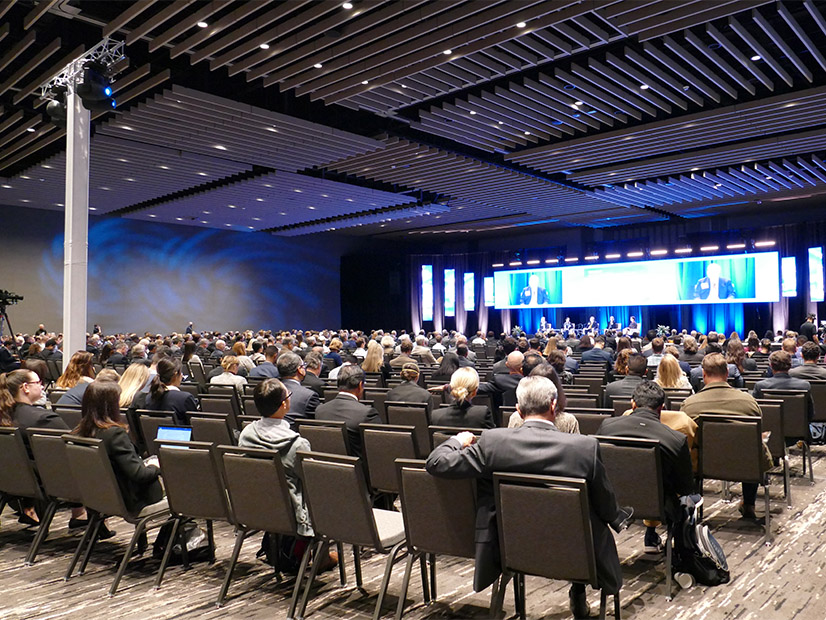SACRAMENTO, Calif. — The need for new transmission to transport clean energy across the West was a key theme of this year’s CAISO Stakeholder Symposium, which returned in person last week to the Sacramento Convention Center Complex after a three-year hiatus.
Solar power from the Southwest, hydropower from the Northwest, and wind from Wyoming and New Mexico will need to flow to California and other states with clean-energy goals in the coming years, panelists said.
“That resource diversity is extremely valuable to the Western Interconnection,” said Maury Galbraith, executive director of the Western Interstate Energy Board. “Transmission is the technology that allows us to leverage that geographic diversity. Transmission is what allows generation and electrons to flow from low-priced areas to high-priced areas and allows us to spread out surpluses and fill in the deficits.”
That will require regional planning of transmission to facilitate market transactions, such as those in CAISO’s interstate Western Energy Imbalance Market (WEIM), he said. The ISO already has been incorporating that need into its transmission planning, Galbraith said, “but I don’t think it’s yet taken over the rest of the West.”
In the future it will have to, he said.
Neil Millar, CAISO vice president of infrastructure and operations planning, said the ISO has had to plan for transmission both internally and externally because of the state’s clean-energy and electrification mandates.
“Five years ago, we were actually dealing with forecasts for transmission planning of flat or even negative load growth,” Millar said. “Now, we’re looking at some of the steepest load-growth forecasts we’ve seen in 15 years. A lot of that is from the emergence of electrification, not only transportation but other industries, that’s driving the requirements, as well as the need to clean the grid in general.”
Until two years ago, CAISO’s 10-year transmission plan, which is updated annually, anticipated the addition of 1,000 MW of new resources per year, he said. This year’s plan projects 4,000 MW of new resources per year, and the “draft portfolios for next year are looking at about 7,000 MW of installed capacity a year,” he said.
California needs the new resources, including solar and storage, to maintain grid reliability while meeting its 100% clean energy mandate by 2045.
CAISO’s first 20-year transmission outlook, published Feb. 1, projected the need for lines traveling from wind farms in Wyoming and New Mexico and a 200-mile undersea line to carry offshore wind from far Northern California to the San Francisco Bay Area. In-state lines to move renewable generation from rural areas to urban load pockets also must be built, CAISO said.
The 20-year outlook estimated the total price tag at $30.5 billion. (See CAISO Sees $30B Need for Tx Development.)
Panelists said a major problem will be who pays for interregional transmission lines.
“Everybody wants to go to heaven, and nobody wants to die when it comes to cost allocation,” said Scott Bolton, senior vice president of transmission and market development at PacifiCorp, prompting laughter.
 Panelists Scott Bolton, PacifiCorp; Maury Galbraith, Western Interstate Energy Board; and Neil Millar, CAISO, discussed Western transmission needs. | © RTO Insider LLC
Panelists Scott Bolton, PacifiCorp; Maury Galbraith, Western Interstate Energy Board; and Neil Millar, CAISO, discussed Western transmission needs. | © RTO Insider LLC
PacifiCorp’s sprawling footprint in the West allows it to build long-haul transmission lines to benefit its own customers, he said. Going forward, utilities like PacifiCorp will need to justify transmission that serves multiple jurisdictions, including CAISO.
“And so, as Maury hits on, which frankly is an underpinning theme of this whole symposium, the emergence of markets needs to become a much more robust part of that analysis,” he said.
PacifiCorp and others will need to “be able to show … that this additional transmission capability being built by others [in the West] contributes to a more robust platform for trading [and] for being able to transact in energy in ways that will lower power costs and be able to deliver those savings to retail customers, just by different means than what we’ve traditionally demonstrated,” he said.
The benefits will have to exceed the $3 billion already achieved through the WEIM since it started in 2014, he said. CAISO’s proposed extended day-ahead market (EDAM) for the WEIM could amplify those benefits.
“We will have to be able to … better optimize the system and lower those production costs and lower the power costs that customers experience,” Bolton said.
“If coordinated right, it should provide those additional benefits beyond just reliability and meeting load growth,” he said. “That’s where the markets discussion is so exciting because it does introduce an opportunity, frankly, to monetize that transmission for customers who are supporting that investment and to really get paid back on that increased market activity [by using] transmission more efficiently and much more dynamically.”


